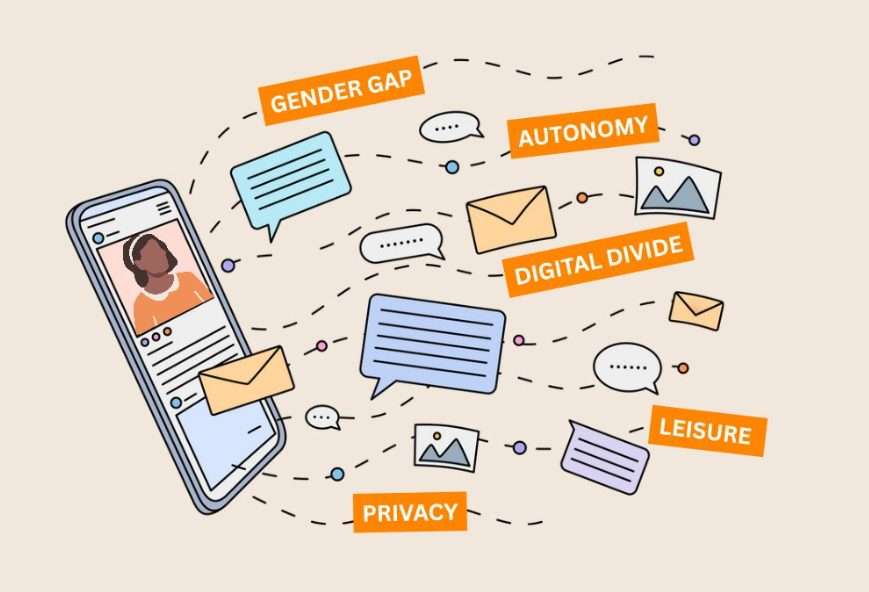What happens when your phone isn’t entirely yours? This piece explores how Indian women navigate digital restrictions and find moments of agency in everyday phone use.
Uncovering the Gendered Realities of Digital India
At first glance, India’s mobile statistics suggest a nation deeply connected—over a billion subscribers and hundreds of millions of smartphones (India Inequality Report, 2022). But these numbers tell only part of the story; while ownership may be widespread, access remains deeply gendered. In 96% of households surveyed, male children received personal smartphones long before their female siblings (Iqbal, 2021).
The disparity wasn’t lost on Hasna, a 20-year-old, who found it deeply unfair: “Boys get smartphones much before girls.” Ramitha, 21, echoed the sentiment: “When we ask our parents for a phone, they ask us, ‘What is the need?’—and say, ‘If you need to call friends, there’s a phone in the house” (Iqbal, 2021).
Even when girls are allowed to use phones, that access is often conditional and closely monitored. Consider Aarti, a 13-year-old girl from rural Rajasthan. Her smartphone use is curtailed with constant reminders not to indulge “too much”. She navigates this by borrowing the device in stolen moments, when no one is watching. “My parents feel bigad jayegi ladki —that I’ll get spoiled,” she explains with a matter-of-factness that belies the underlying injustice (TOI News Report, 2023). Such instances tell us that women and girls across India are expected to engage with technology under conditions that are restrictive, often invisible, and deeply gendered. Therefore, there is a need to understand shared access behaviour and privacy constraints better with the aim of ensuring equitable digital access across all sections of society.
How Gender Governs Digital Access at Home
In many households, economic constraints mean only one smartphone is purchased and shared among all members (SIDE, 2023, p. 61). For those without their own devices, shared use is often the only way to get online. “Shared access,” as defined by Burrell (2010), refers to multiple people using a single device, typically in communal spaces. It’s a common practice across several developing countries (James, 2011); in India, women make up a staggering 77% of all shared device users, highlighting a significant imbalance between men and women (Internet in India Report, 2023).
Research shows that women are more often the borrowers or secondary users, while men are seen as the primary owners and decision-makers around digital access (Sambasivan et al., 2018.). Even within shared spaces, power over technology is unevenly distributed. When women do possess their own phones, they’re often culturally expected to share their devices with other members of the household, highlighting that sharing behaviour amongst women occurs not only out of necessity but as a social obligation. In a study involving women across India, Pakistan, and Bangladesh, researchers found that phone use was rarely private. “In practice, this could involve multiple onlookers as they used their device, having their device passed between multiple people, or using a device that was primarily shared in nature” (Sambasivan et al., 2018). Unlike men, women often face an unspoken obligation to make their devices communal, implying that ownership does not guarantee autonomy. What’s at stake here isn’t just access—but agency, privacy, and dignity.
Navigating Communal Living and Digital Boundaries
In many Indian households, the concept of privacy simply does not exist in the way we often imagine it. As one study notes, “The term [privacy] itself was sometimes considered objectionable…it was not a part of this cultural ethos that emphasized openness” (Sambasivan et al., 2018). For example, the practice of “open doors” in Indian homes, though seemingly minor, highlights how communal living often takes precedence over individual privacy.
“As children, Indians are taught to leave their bedroom doors open, even when they go to bed. In many houses, both in rural and urban India, locking your door even as adults — unless you’re changing clothes — is considered an act of secrecy and not privacy. Not only that but it is often the parents, the adults of the family or the community that decide what one can wear, what one can eat, who can one talk to or what one can share with each other” (DEF Report, 2017).
It’s a reality many Indians have grown up with, where the boundaries between personal space and shared space are often blurred. This isn’t to suggest a lack of appreciation for individuality, but rather to highlight how the concept of ‘personal’ is often interwoven with the ‘communal.’
These privacy constraints vary significantly across socio-economic strata, disproportionately impacting women in semi-urban and rural areas. In 2018, for instance, a village panchayat in Haryana banned girls from wearing jeans and using mobile phones under the pretext of preserving tradition—prompting a teenager to ask, “Why is it always the girls who are told what to wear or what to use?” (DH News Report, 2018). Similarly, a panchayat in Uttar Pradesh’s Mathura district imposed a fine of ₹2,100 on girls found using mobile phones outside their homes (The Hindu New Report, 2017). These examples highlight how digital and physical autonomy for women is often curtailed through community-level restrictions, particularly in lower-income, rural settings (GSMA Report, 2024, Pg 5).
There is a systemic denial of digital access to women in India that goes beyond financial constraints to include deep-rooted social restrictions (Iqbal, 2021). The lack of physical privacy translates into limited digital privacy, creating a landscape where women’s online activities are often subject to scrutiny and supervision. Fathers in conservative families insist that “….girls who have access to digital technologies get spoiled. Unfiltered information can ruin girls [and not boys]” (Bhatia, Arora, & Pathak-Shelat, 2021) – it reflects a widespread fear that the internet will corrupt “good girls.” As a result, families impose strict controls “for their safety”, male members of the family often “gatekeeping” usage and even forbidding personal devices (Sharma et al., 2025).
How Women Carve Out Digital Autonomy
Despite the pervasive restrictions and gatekeeping, Indian women actively seek moments of digital autonomy. As one study notes, “most of the girls have access to shared digital technologies, but they have devised strategies to use these technologies in ways that allow them to experience privacy and autonomy in meaningful ways” (Bhatia, Arora, & Pathak-Shelat, 2021). They strategically delete browsing histories and call logs, use coded language or emojis, time their device usage, create separate accounts or apps, discreetly borrow phones or utilize shared devices, and employ passcodes—all to carve out small windows of time for themselves—to leisurely browse the internet, check social media, or quietly observe their peers’ lives online. In the Good Girls Don’t Go Online study, one teenager from a conservative family described creating a nameless Facebook profile, not to post or engage, but to passively view her classmates’ behaviours out of curiosity (Bhatia, Arora, & Pathak-Shelat, 2021). Even within restrictive digital environments, women subtly reclaim their agency by engaging in what we can call “digital leisure”—through activities like browsing social media or watching videos, not just for information, but for connection, curiosity, and a sense of freedom.
What It Takes to Sustain Women’s Digital Autonomy
While these strategies are innovative and adaptive, they are inherently short-term solutions. Having to constantly erase data prevents women from establishing a stable online identity and engaging in sustained digital use. Similarly, relying on brief, borrowed access restricts their ability to fully explore and develop digital skills.
It is clear that women are investing a significant amount of emotional labour and creativity just to get online. From managing device sharing at home to safeguarding their digital footprint, the effort it takes to simply browse or participate is often invisible, yet immense. There is a need to develop practical, near-term solutions that could help formalise some of the access they’re already negotiating. These small, intentional steps could start to ease the pressure on women, making digital participation not just possible—but sustainable, safe, and supported.
Digital Leisure as a Gateway to Digital Adoption
In today’s fast-paced world, digital leisure time represents an important aspect of our daily lives. This is the time we spend immersed in digital worlds, seeking entertainment, enlightenment, and connection, or simply a break from the day’s burdens. In India, more than a third of our population engages with social media and entertainment platforms on a daily basis (Meltwater, 2025).
Arora and Rangaswamy observed that using technology during our free time could go beyond being just entertaining – it could be educational (2013). They point out that these leisure activities can help boost digital confidence, especially since 40% of women say they don’t use the internet because they’re not comfortable with technology (Women and Web Report, 2013). Moreover, these casual tech habits can open doors to more serious benefits like easier access to educational materials, job opportunities, healthcare, and financial management. A notable portion of both men and women—around 3 in 10—are aware of the internet but don’t use it, often citing a “lack of relevance” as the main reason (GSMA Report, 2024, p. 62). In this context, digital leisure could offer a more relatable entry point, presenting the internet as something that connects to everyday interests and enjoyment.
Although digital leisure can be a great way to get familiar with new technology, not everyone feels they have the right to this kind of leisure time. Research has shown that cultural expectations can make it difficult for women to take time out for themselves (Saxena, 2021). They are often expected to prioritize household chores over relaxing or exploring digital platforms. As a result, men tend to use these technologies more frequently, becoming more proficient with devices like smartphones. This gender gap in digital skills can keep women from enjoying the full benefits of our digital world (Iqbal 2021).
In conclusion, the journey towards genuine digital inclusion for Indian women is rife with socio-cultural and economic barriers, yet digital leisure presents a potentially promising entry point. What begins as simple entertainment can evolve into a powerful tool for building essential digital skills and boosting self-confidence in technology usage (Arora, 2013). By focusing on both immediate solutions to improve access and long-term strategies that promote privacy and autonomy, we can aim to create a supportive digital environment where women can thrive, contributing to closing the gender gap in digital access. The goal should not be to correct how women navigate the digital world, but to build upon it—ensuring they no longer need to hide or innovate alone in order to participate fully.
Image Credit: Generated through Canva
This article was first published on GxD (Gender x Digital) hub’s Blog. GxD hub is an initiative of LEAD at Krea University. Read the original piece here.
About the Authors
Rasika Gopalakrishnan is a Research Associate at the GxD hub. She holds a Master’s degree in International Human Rights from the University of Denver and a Bachelor’s degree in Psychology from Ashoka University. Rasika is passionate about utilising data-driven research to shape policies that benefit traditionally underserved communities.
Vaidehi Sahasrabhojanee is a Policy Associate at the GxD hub. She holds a Master’s degree in Public Policy from Christ University, Bangalore, and a Bachelor’s degree in Sociology from the Manipal Centre for Humanities, Manipal. Vaidehi is deeply passionate about mental health and human rights, with a keen interest in exploring their intersection within the framework of government policies.


